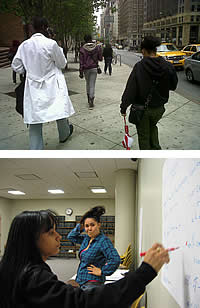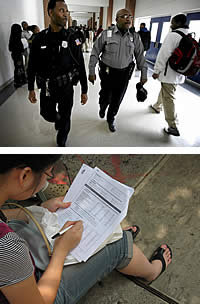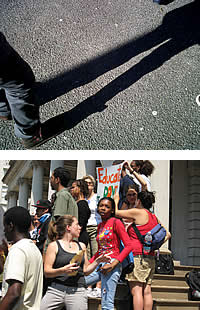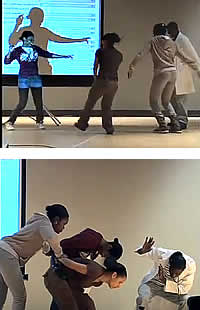by Kathleen Cushman
NEW YORK CITY—Toward the beginning of the political theater piece that culminated the Polling for Justice participatory action research project, a pompous figure called Dr. Researchy took the stage. Wearing lab coat and spectacles and clutching a sheaf of papers, he mumbled his supposed academic findings about “this problematic situation” of urban adolescents. From across the audience, one could hear young people’s voices calling out in protest:
View YouTube video (youth’s political theater piece plus CUNY professor Michelle Fine’s introductory remarks at Halifax conference)
“No one understands him but himself!”
“You know what, I’m going to go up there and say something!”
One by one, the other young actors then claimed the stage to give their own side of the story. With home-grown evidence and striking tableaus, they brought to life their own conclusions from a very different kind of study—collaborative, youth-led, outspoken, and thoroughly authentic.
These high-school-age students worked for two years on the Polling for Justice study, as part of the Public Science Project, a decade-long initiative linking young people with faculty and students at the City University of New York (CUNY), researchers, and youth-centered community organizations. It aims to move urban youth (ages 16 to 21) from the margins to the center of academic inquiry, coaching them to simultaneously investigate and challenge the conditions of their lives.
“Sometimes we have the disadvantage of people thinking teens don’t know what older people know,” said Maybelline Santos, a team member from the Bronx who will start college next year. “But who says teens can’t be also researchers? We don’t need a degree, we don’t need a textbook, to be experts about our own lives.”
Asking the questions
Beginning in January 2008, the Polling for Justice project set out to describe the experiences of youth from all five boroughs of New York City. “A teen’s life, that’s what this revolves around,” Maybelline said.
 Together with their CUNY partners, the young researchers created a survey to help identify whether, and how, public policies “dispossess” certain adolescents from access to high-quality education, health care, and policing or criminal justice.
Together with their CUNY partners, the young researchers created a survey to help identify whether, and how, public policies “dispossess” certain adolescents from access to high-quality education, health care, and policing or criminal justice.
Particularly with young people marginalized by skin color, family income, sexual orientation, or immigration status, the team conjectured that the inequities of everyday life could be taking a significant toll on their mental and physical health.
Would depression show up more, for example, in youth who felt harassed by police or school authorities? “Sometimes depression has to do with the educational or police system, not necessarily just home life,” noted Candace Greene. Disrespect and rudeness aimed at youth by those in power, she suggested, might prove the last straw for someone with family burdens to bear as well.
To start their study, the young researchers set out to learn the ropes of academic research. In a “research camp” facilitated by CUNY graduate students, they and other participants acquainted themselves with the political and social struggles of New York’s activist past. As they developed a shared language of theory and methods, they paid attention not just to scholarly articles and policy briefs, but also to hip hop and to the experiences of other campaigns for justice.
From this common base, they began crafting their survey. Some questions they kept standardized: “Have you ever dropped out or been pushed out of high school? Have you ever been in jail or prison? Have you ever been homeless?” Others were more open-ended, probing for the extent to which money, health, housing, education, police caused stress in the lives of youth.
Making links, in person and online
The researchers framed their questions in a form that would reach youth tired of answering multiple-choice questions on tests. Otherwise, said Darius Francis, “They’re not going to do it. You hand them a paper and they’re going to be like, ‘I ain’t filling this out. I’m-a throw it out.’ You have to explain what it is they’re going to fill out, and why, and what’s the purpose.”
But creating their instrument was not the only challenge. “We had to make decisions on how we were going to distribute the survey,” Maybelline said, “because the Board of Ed wouldn’t allow it in the schools.”
In part, Darius speculated, school authorities might not have liked the questions this team was asking. “It’s going to expose something that they’re trying to keep undercover,” he said. “Like why are cops actually in schools—not just safety agents but actual cops? They say that it’s for our safety and their safety. But it’s more than that.” Otherwise, these students say, why are 5,000 New York City police officers assigned to duty inside their public schools?
Forging connections with other youth organizations allowed the young researchers to gather many survey responses in person. “It’s a mutual agreement,” Maybelline explained. “We’ll set a date to go see [an organization], then they’ll explain their project to us, and we’ll explain ours to them. If they’re creating a survey, we’ll exchange. They’ll fill out ours, we’ll fill out theirs.”
In the end, however, Polling for Justice gathered most of its 1,110 completed surveys by making it available on social networking sites. “We sent friend requests to everyone, and we put up links,” said Maybelline. “It was easier for most people, because young people like to be on computers nowadays.”
“If you filled out the survey, we gave you a new movie ticket,” Darius added. “I guess that worked.”
Two thirds of the responses came from girls, their data showed. Nine out of ten of the surveys returned came from youth of color; about ten percent of respondents identified as LGBQ.
Behind vulnerability and resilience
Digging into the survey’s statistical output together, the young researchers and their CUNY counterparts found their hunch confirmed. Experiencing “dispossession” did seem literally to “get under the skin” of young people, making them more vulnerable to health and safety problems of many kinds.
Dispossession itself showed up most in high-poverty communities, with youth of color, with males, and with LGBQ youth, they discovered. And while the most dispossessed youth represented less than a third of the total sample (31%), they accounted for nearly two thirds (64%) of all the dispossessing incidents the survey measured.
Youth in their “most dispossessed” category were nearly six times more likely to engage with violence, more than four times more likely to engage in unsafe sex practices, almost three times more likely to use illegal drugs, and twice as likely to report clinical depression as the youth in the “least dispossessed” category, the researchers said.
Yet the numbers also revealed significant cause for hope that public policy could make a real difference in the lives of youth. Even in the most dispossessed conditions, substantial percentages of youth replied that they were not engaging in violence or unsafe sex, not using alcohol and drugs, not suffering from depression. Using depression as a test case, the researchers dug deeper for the reasons some youth seemed more resilient in similar harsh circumstances.
The difference, they now believe, is that more resilient youth report having more trusting relationships with educators, as well as more involvement with youth organizing or organizations. And public policies, they say, could significantly boost the likelihood of that.
Maybelline, for example, said that in her Bronx neighborhood, police harassment is a big issue for youth. “They’re everywhere,” she said. According to the researchers, she has experienced “accumulated policy dispossession in terms of educational experiences, healthcare, and home and family life.” Yet she proudly graduated from high school this week, and earned her nursing assistant certificate as well. She credits her success to “the meaningful relationships she has with adults in her family, her community, at school, and through youth organizations,” the researchers reported.
‘Playback’ turns research into action
Polling for Justice also had another important goal: to build coalitions with other youth in similar situations around the world. The next step, they decided, was to make public their findings in the most dramatic way possible: theater.
“You don’t want to sit there and just look at a number on a chart,” declared Darius. “I know I’m not going to understand it. But when somebody performs those numbers for you, its like putting a face to the numbers.”
At the Remapping Progressive Education conference in Manhattan, held by the Meier Institute in April 2010, the group drew applause from an audience of several hundred educators as they used metaphor, humor, maps, graphs, and numbers to dramatize the youth issues they had identified.
 Darius, for example, played a student without a subway pass, who jumped the turnstile in order to get to school on time. Who the police stop in such situations, he said later, “plays into race, and into where you come from.” The Polling for Justice survey data backs him up: 61 percent of youth in the Bronx and 58 percent in Brooklyn reported negative contact with police.
Darius, for example, played a student without a subway pass, who jumped the turnstile in order to get to school on time. Who the police stop in such situations, he said later, “plays into race, and into where you come from.” The Polling for Justice survey data backs him up: 61 percent of youth in the Bronx and 58 percent in Brooklyn reported negative contact with police.
“Youth are always going to be looked down on,” said Maybelline, agreeing that adults profile youth by color, gender, and the neighborhood they live. “They look at me like, ‘Oh, she’s Spanish, she might make a dropout, have a kid.’” As the group presented its findings in dramatic form, she said, it helped others confront such stereotypes on an emotional level.
“We always make sure we ask the audience for their feedback,” Darius explained. “Once we have it, we go into making fluid sculptures of what their feelings are.”
When the audience consists of youth, the performance has added importance, he said. “When we tell them these stories, it also shows that we’re not just kids. The wheels are turning. We have minds of our own.”
The hope, he said, is to “inspire you to take action—to do more than just take in the information but actually go out and do something about it.”
In early June 2010, just as the group members graduated, they performed for an international conference on resiliency, held in Halifax, Canada. They came back elated, eager to keep up their work as they took up their college studies. “It was just amazing to see,” said Darius. “There’s a lot of people from all over the place, really caring about what youth are doing.”
The goal, these young researchers agree, is both understanding and action. At the end of the theater piece, Jaquana Pearson addressed the audience:
“Injustice still exists, so we all have to come up with the ending together,” she said. “We need your help writing the last line. What should the next steps be?”





